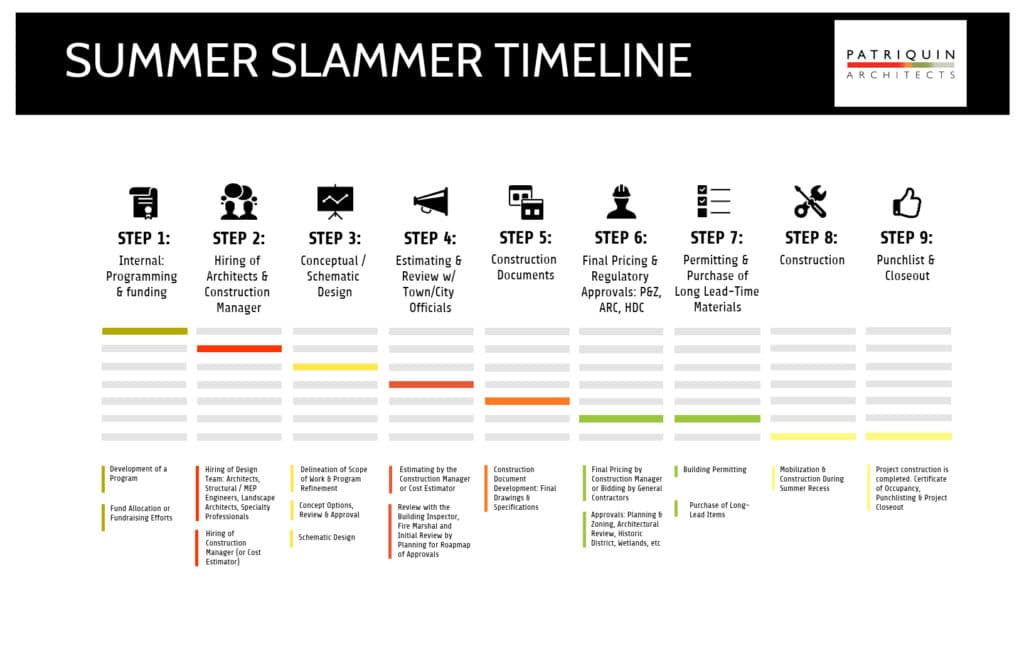Design and construction projects for schools involve unique challenges. One of the biggest is ensuring that work is completed in the summer months when students are away so that construction activities aren’t a distraction. Avoiding construction zones in a building during the school year also helps mitigate safety concerns.
Given their time-sensitive nature, these projects are often referred to as “summer slammers.” In order to execute one and meet established deadlines, it’s critical to have a carefully defined project timeline.
Who to Involve in Summer Slammers
In order for a summer slammer school construction project to be successful, the right people must be involved. This includes:
-
- School Owner. The school “Owner” may be the head of the school, its board members, or a formalized building committee. Whoever is in charge provides a crucial perspective when planning and executing the project.
- Owner’s Representative. In some cases, a school’s owner may have what’s referred to as an owner’s representative who attends meetings and makes decisions on their behalf. Sometimes also referred to as the Owner’s Project Manager (OPM), this consultant attends programming, design and construction meetings and helps the Owner navigate through the complexities of large of fast-paced projects.
- Real Estate Attorney. The project may involve legal representation when project work triggers zoning, wetlands or other regulatory approvals.
- Architectural team. This is often a group that includes the architects and experts in structural engineering, MEP/FP (mechanical, electrical, plumbing/fire protection) engineering, site/civil engineering, and landscape design. Specialty professionals such as geotechnical engineering, energy modeling, acoustical, security and data, furniture sourcing, and others may also be involved.
- Environmental Engineers. These professionals, hired directly by the Owner, test building materials for hazardous materials in the area of the proposed project and prepare an abatement scope of work for the construction team.
- Construction Manager (or Cost Estimator and General Contractor). This entity will also have sub-contractors who perform work under the construction company’s contract. The CM or GC is charged with hiring subcontractors to perform the work.
- Building Inspectors and Fire Marshals. These agents are tasked by the State and local Cities/Towns to oversee building permits and inspections for occupancy. Working closely with these authorities having jurisdiction is key during design and construction in order to stay on schedule.
Due to the large number of voices involved, summer slammers require exceptional skill in scheduling and communication.
How a Summer Slammer Unfolds
 While every school construction initiative is unique, there are certain steps and milestones that are common to most projects. They include:
While every school construction initiative is unique, there are certain steps and milestones that are common to most projects. They include:
-
-
- Development of a program (i.e., a list of elements to be designed/renovated/repaired)
- Fund allocation or fundraising efforts
- The hiring of the architectural team
- Environmental assessments for hazardous materials
- Delineation of the scope of work (often referred to as the S-O-W) and program refinement
- Hiring of the Construction Manager or Cost Estimator
- Conceptual/schematic design (followed by design development)
- Estimating by a Construction Manager or Cost Estimator
- Review with the Building Inspector and Fire Marshal
- Construction document development
- Bidding/final estimating or development of a guaranteed maximum price
- Ordering of long-lead-time items (by the General Contractor or Construction Manager)
- Permitting (including planning and zoning requirements, architectural review board approval, and a Certificate of Appropriateness from a historic district commission if appropriate)
- Mobilization and go!
-
When the project reaches this point, the General Contractor or Construction Manager manages the detailed construction schedule—from demolition (if needed) and construction to achieving the Certificate of Occupancy and addressing “punch list” items before “handing over the keys” to school officials.
How Patriquin Architects Approaches Summer Slammers
Although the steps in a summer slammer may be fairly standard, the amount of time necessary to complete each of them varies widely. What regulatory bodies will be involved and how long will it take to get approvals? Is demolition required, and if so, how much time before the site is ready for construction? Are there items needed for the construction or renovation that will take a long time to obtain?
Fortunately, our extensive experience with these kinds of projects helps us contribute valuable insights to timeline discussions. By leveraging our expertise along with that of the other stakeholders, we’re able to come up with a schedule that works for both the school and the construction team. And when the doors are opened in the fall, students return to a building or a campus that has been transformed to better meet their needs.
Considering a summer slammer for your school? The more lead time you can give to the design and construction teams, the better! Contact us at your convenience and let’s talk about your goals and how our team can help you achieve them.
